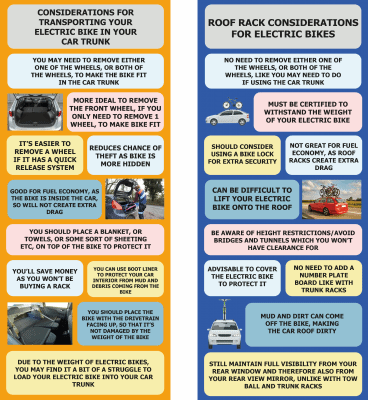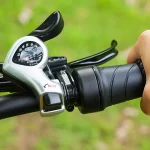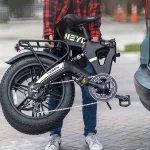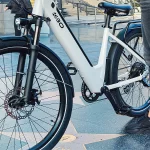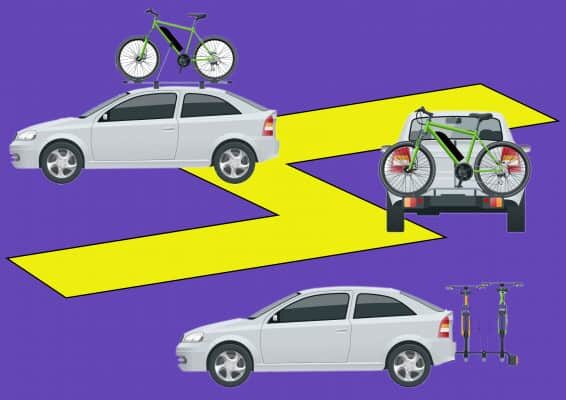
You may have been riding your electric bike around your local area, but you might now wish to explore new cycling routes. It may be that you wish to go on some electric bike cycling adventures, but you don’t have very exciting trails on your doorstep in the first place. Therefore, you may be wondering what is the best way to transport your electric bike to broaden your cycling horizons.
If you wish to transport your electric bike, there are various methods of doing so. These include transporting your electric bike in a car trunk, on a roof rack, on a trunk rack, in a van, or even on the rear of a pickup truck. There are various advantages and disadvantages to all of these methods. So whichever of these methods you would opt for, it would be down to which one suits you best.
Here in this article, I discuss the most common methods of transporting electric bikes at length. This is to help you decide which method you feel is best for you. Hopefully, this will help you get out there on more cycling adventures and get the most out of your electric bike.
Table of Contents
Weight Consideration
Before going any further, it’s worth mentioning a very important consideration for when you’re transporting an electric bike. This is that electric bikes are a lot heavier than regular bikes. So you should take this into account when deciding on a suitable method to transport your electric bike. For example, if you’re using a rear rack, then you must make sure it can support the weight of your electric bike. A tip here though, is that if the battery is detachable, then you can remove it for when you’re transporting your electric bike. This in turn will make your electric bike lighter.
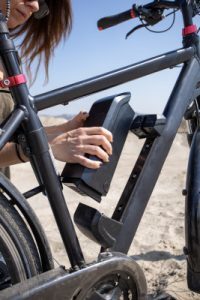
Transporting an Electric Bike Considerations Infographics
Below are infographics, highlighting some of the main considerations, for some of the most common ways of transporting electric bikes.
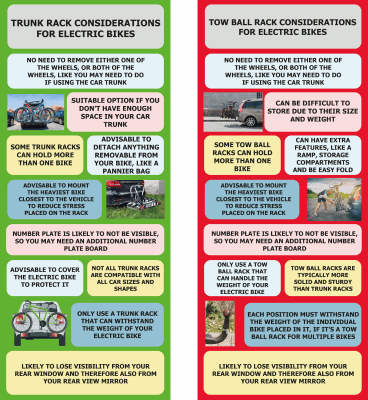
Transporting an Electric Bike in a Car Trunk
Providing you’ve got the space, you can simply just put your electric bike in the trunk/boot of your car. This is a lot easier if you have an estate car (UK), or a station wagon (US), as these provide plenty more trunk space. Even if you have a car with less trunk space, you may still be able to fit an electric bike. You may have to adapt to the situation though. For example, you may need to remove either the front wheel, or maybe even both wheels. Additionally, you may need to fold down the rear seats, or the passenger seat. Nevertheless, with a bit of ingenuity, you should be able to fit an electric bike in the trunk of most cars.
Below are various considerations with regard to using a car trunk to transport your electric bike.
- Firstly, transporting your electric bike in your car boot is free. This is because you’re not buying a rack.
- Using a car boot to transport your electric bike, is better for fuel economy compared to using racks. As the bikes are inside, they are not ruining the airflow around the car, causing more drag. This comes into its own even more when motorway driving.
- You’re not advertising to the outside world that you’re taking a bike, or bikes with you. This helps reduce the chance of theft. There have been known cases where people carrying bikes outside the car on a rack have been followed home by bike thieves.
- As mentioned above, you may have to take off either the front wheel, or both wheels, to make the bike fit in the trunk. This will mean that you’ll have to spend a bit of time reattaching the wheel at your destination. Additionally, you’ll then need to detach it again after your ride, before putting your bike back in the car. This can be a bit of a faff and time-consuming, depending on how easy it is to attach and detach the wheel.
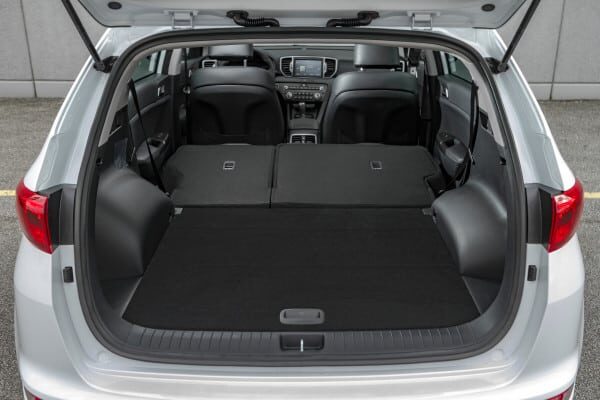
- Following from above, it’s easier to remove a bike wheel if your bike has a quick release mechanism. This will mean you can easily and quickly, detach and reattach the wheel without using any tools. You just open and close the cam lever. Some bikes, hold the wheels on by bolts, in which case you’ll need spanners to remove the wheels. This is more of a faff and time-consuming. Generally speaking though, the newer the bike, the more likely it’ll have a quick release mechanism.
- If you only need to remove one wheel to make your electric bike fit in the car trunk, then it’s most ideal to remove the front one. This is because it’s easier to remove. Also the rear wheel helps protect the rear mechanism.
- Removing a wheel is easy if you have a disc brake. Here, you would usually have a thru-axle which has a lever. You can just turn this lever to allow you to pull out the thru-axle, to then allow you to remove the wheel. Not all thru-axles have one of these levers though. Instead, here you would usually need an allen key to remove the thru-axle. After you’ve removed the wheel, you can then put the thru-axle back in the bike so that it doesn’t get lost. This also helps maintain structural integrity.
- Don’t place your electric bike upside down whilst removing a wheel. This is because you may damage the controls on the handlebars.
- Remembering that electric bikes are heavy, you may find it a bit of a struggle to lift your electric bike into your car trunk. For example, you may be of advancing years, which may be why you have an electric bike in the first place. Therefore, when lifting the bike into the trunk, you can grab the forks with one hand and the seat tube with the other. This gives you a good even weight distribution, making the electric bike easier to carry.
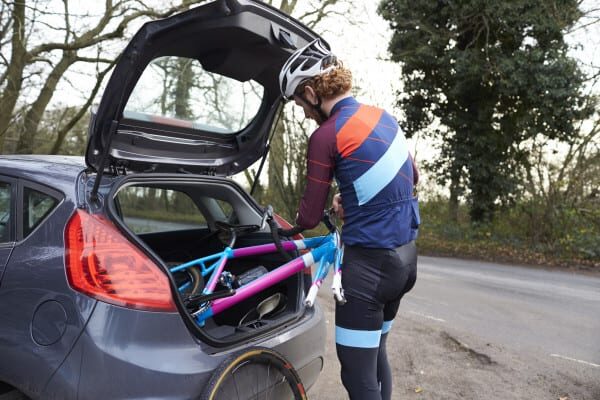
- To protect the interior of your car trunk from debris, mud and chain oil, etc., you can buy boot liner
 . This is a synthetic mat that you can place on the surface of your car trunk. You then place your electric bike on top of it. Alternatively, you could use a blanket, towels, or some form of sheeting instead, to place your electric bike on. Additionally, you can also use a blanket, towels, or some form of sheeting to place on top of your electric bike, to protect it. If you’ve removed a wheel, or both wheels, you can then place it/them on top of whatever you’ve used to cover your bike. Covering your electric bike whilst it’s in your car trunk is also good for security. This is due to the fact that it reduces the visibility of your bike, through your car windows.
. This is a synthetic mat that you can place on the surface of your car trunk. You then place your electric bike on top of it. Alternatively, you could use a blanket, towels, or some form of sheeting instead, to place your electric bike on. Additionally, you can also use a blanket, towels, or some form of sheeting to place on top of your electric bike, to protect it. If you’ve removed a wheel, or both wheels, you can then place it/them on top of whatever you’ve used to cover your bike. Covering your electric bike whilst it’s in your car trunk is also good for security. This is due to the fact that it reduces the visibility of your bike, through your car windows. - If you’re taking other luggage in your car trunk, it’s a good idea to put this in first. You can then place your electric bike on top, so that it isn’t crushed. Items placed on top of your electric bike could damage parts. Ideally, you should still have a protective layer between your electric bike and the other luggage. Again, this can be a blanket, towels, bubble wrap, rugs, etc. If you’re taking more than one bike in your trunk, you could stack bikes on top of each other, if you have room. Be careful though and be sure to have suitable protective padding between bikes.
- When placing your electric bike in the car trunk, you should make sure the drivetrain is facing up. This is so the weight of the bike is not resting on it, which can possibly damage parts. You should be careful in general when placing your electric bike in your car trunk. Place and slide it in gently to reduce the chance of any parts catching, or getting damaged.
- If you’ve removed a wheel then you should place a spacer in between the brake calipers. This is because the brake can still actuate with the wheel removed, whilst the bike is being transported. If there’s no wheel or rotor between the calipers, then they might close against each other. You can push them out afterwards, but it’s a bit of a faff and may require a tool. You can buy dedicated brake spacers, or you can just use a folded up business card.
Transporting an Electric Bike by Roof Rack
Roof racks are pretty much self-explanatory. These are racks that allow you to attach bikes to the roof of your vehicle. Below are various considerations with regard to using a roof rack to transport your electric bike.
- A roof rack can be a suitable option to avoid the disadvantages of other electric bike transportation methods. This can include not having to attach a number plate board and not going without visibility from your rear window and rear-view mirror. Both factors which can occur if you’re using a trunk mounted rack. You also don’t have to remove a wheel, which you may need to do if you’re transporting your bike in your car trunk. Also, you may not have room in your trunk for an electric bike. This may be because you’re unable to fold the rear seats down if you have passengers in the back.
- You may find it difficult to lift your electric bike up onto the car roof. Remember electric bikes are heavier than regular bikes. You may find it harder to lift your electric bike onto the car roof if you have back problems, have a weaker upper body, or are of advancing years etc. Again, these are all reasons why you may have an electric bike in the first place. As mentioned before, you could remove the battery to make your electric bike lighter. You can then put the battery in a safe place in the car whilst traveling.
- You should make sure that if you’re using a roof rack, then it is certified to withstand the weight of your electric bike. Again, due to the extra weight electric bikes carry, this is particularly important.
- It’s advisable to have a cover on your electric bike if you have it on a roof rack. This is to protect against rain water from getting into the electrical components that can possibly cause damage. If it’s raining heavily and you’re driving at high speed on a highway/motorway, then this can act like a pressure washer on your electric bike. This is certainly not ideal, as a lot of water could be drawn into the electric components at force. Also, a cover will help prevent contamination from the cars fumes, which can lead to bike parts rusting.
- Transporting your electric bike on a roof rack can leave your car roof in a bit of a state. This applies more if you’re driving back home after a ride. Any mud and debris that may be on your electric bike can fall onto the roof. This can especially be the case if it’s raining. However, again, having a cover over your bike will help here.
- Using a roof rack is not great for fuel economy. This is due to that it causes more drag whilst you’re driving.
- You should be aware of height restrictions when transporting a bike on a roof rack. You must avoid bridges and tunnels that will be too low for you to pass through. Therefore, it’s a very good idea to plan your route in advance if you’re using a roof rack. As part of doing this, you should also establish the height of your vehicle with your bike and roof rack on top.
- For extra security, you should consider using a lock to minimize the chance of theft. A lot of the time roof racks will have their own locking mechanism already included. However, it wouldn’t hurt to have an additional separate lock to enhance the security further. There’s always a chance your electric bike could be stolen, if you’ve stopped off somewhere and you don’t have good security.
Transporting an Electric Bike by Trunk Rack
Like with roof racks, trunk racks are relatively self-explanatory. A trunk rack is a rack for transporting a bike, or bikes, that attaches at the back of your vehicle. Below are various considerations with regard to using a trunk rack to transport your electric bike.
- A trunk rack is a suitable option if you don’t have space in your car trunk for an electric bike. It’s also suitable if you’re unable to lift your electric bike onto the car roof.
- Like with roof racks, you should make sure you only use a trunk rack that can withstand the weight of your electric bike. Remembering that electric bikes are heavier than regular bikes, it may be a good idea to buy a trunk rack that is electric bike specific. Again, you can take the battery out to make the bike lighter. This will help reduce the stress placed on the rack. If there’s too much weight, causing too much stress, it can cause the rack to snap off.
- There are lots of different trunk racks available on the market to suit different shape and size cars. Therefore, not all trunk racks are compatible with all cars. So this is another consideration when buying a trunk rack.
- Some trunk racks are designed to be able to hold more than one bike. Again, it’s important to make sure these racks can handle the weight of the electric bikes you place on them. The particular point to consider here though, is that each position on the rack must withstand the weight of the individual bike placed in it. For example, if you have a rack that can handle 2 bikes up to 40lbs each, it would not be able to handle a single 80lbs bike. So only use a trunk rack if the manufacturer states that each position can handle the weight of each individual bike placed on it.
- Following from above, the heaviest bike should be mounted closest to the vehicle. This will reduce the total amount of forces the rack has to deal with.
- It is a good idea to remove anything from the bike that is easily removable. Like any pannier bags, or bike lights for example. Any removable parts are going to be vulnerable to theft if you’re parked up during a stop off. Like say if you‘ve stopped for a bite to eat somewhere.
- If you remove the battery from your electric bike, it will make it easier to lift the bike onto and from the rack. Detaching the battery also helps with safety. If your electric bike has a throttle, without the battery, you’ll be unable to engage the throttle when loading the bike onto the rack. This also applies to when you’re removing the bike from the rack.

- Having a trunk rack will likely cause you to lose visibility through the vehicle’s rear window. So in turn, you won’t have visibility from your rear view mirror. This is an important factor to take into account, when deciding if using a trunk rack will suit you. You would certainly need to be more careful when reversing and carrying out any other driving maneuvers.
- Trunk racks are better for your fuel economy than roof racks. This is due to the fact that they cause far less drag than roof racks. The reason being is that the bikes are tucked away behind your vehicle.
- Trunk racks obscure your number plate. You may be able to get away with this though if your number plate is low down enough. However, if your trunk rack is obscuring your number plate, then you’ll need an additional number plate board. This will therefore be an extra cost. Nevertheless, make sure you’re road legal before driving off with a trunk rack. You don’t want to end up getting a fine.
- Like I mentioned further above with regard to roof racks, it’s a good idea to use a bike lock. Again, this is in addition to any locking mechanism that may already come with the rack. This will improve security, which is important due to your bike being external from the car.
- Also, just like with roof racks, it’s ideal to use a cover for your electric bike if using a trunk rack. This will protect your bike from heavy rain and contamination whilst you’re driving.
Transporting an Electric Bike by Tow Ball Rack
A tow ball rack is similar to a trunk rack, in that it’s used to transport bikes externally at the rear of the vehicle. The difference is though, is that tow ball racks attach directly to a tow ball. This is providing your vehicle does have a tow ball. Below are various considerations with regard to using a tow ball rack to transport your electric bike.
- Tow ball racks are typically more solid and sturdy than trunk racks. Therefore, a tow ball rack is going to be more likely than a trunk rack to be able to withstand an electric bike. However, if using a tow ball rack, you should always still check, though, that the specified maximum weight allowance is high enough to cover the weight of your electric bike.
- You can get tow ball racks that can carry more than 1 electric bike. Some can carry 2, 3 or 4 electric bikes. Like with trunk racks though, each position must withstand the weight of the individual bike placed onto it.
- Tow ball racks can have special features. These can include storage compartments, a ramp to easily wheel your bike onto and off the rack and some that fold up for easy storage, for when not attached to the vehicle. The ramp is especially handy if you’re transporting an electric bike. This is because the weight of electric bikes can make it difficult for some people to lift them onto and off a rack. Thule makes a very good foldable rack, called the Thule Easyfold. Any tow ball rack that does have special features though, would typically be higher in price.
- Following from above, tow ball racks can be difficult to store if they’re not foldable. This is due to the size and weight of them. Unless you do have a garage, you may possibly not have anywhere to store a tow ball rack. In which case, if you are opting for a tow ball rack, a foldable option may be your only bet.
- When using a tow ball rack, you’ll likely experience the same aspects as with using a trunk rack. These include that you’ll likely need an additional number plate board, have no visibility from your rear view mirror and have a better fuel economy than if you’re using a roof rack. This is due to them being positioned at the same part of the vehicle as a trunk rack.
- If your vehicle does not have a tow ball already, then you’ll need to buy one to be able to have a tow ball rack. This will be an extra expense.
- Tow ball racks can be very wide. If you have a compact vehicle, then a tow ball rack may be sticking out quite a lot. Therefore, you should be mindful of this when maneuvering the vehicle. For example, when you’re parking.
- Tow ball racks (and trunk racks as well for that matter) give you limited access to your trunk. Some tow ball racks and trunk racks can pivot, or slide out of the way though. However, your access will still be limited.
Transporting an Electric Bike by Pickup Truck
If you have a pickup truck, then this will be ideal for transporting electric bikes. Below are various considerations with regard to using a pickup truck to transport your electric bike.
- These have no weight limit, so you’ll have no concerns there. They also have plenty of space for not only one electric bike, but a few electric bikes.
- If you have an electric bike at the back of a pickup truck, be sure to have it locked. Remember the bike will be exposed to the outside world and so will be vulnerable to theft if not locked.
- Like with using racks, it’s a good idea to use a cover to protect your electric bike from the elements, if using a pickup truck.
- If you’re transporting an electric bike, or electric bikes on a pickup truck, then it’s a good idea to use a tailgate pad. These secure your electric bike over the tailgate of the pickup truck, to prevent your bike from moving about. Tailgate pads are well padded to protect both your electric bike and your truck from damage. This video talks about how to secure a tailgate pad to your pickup truck.
Transporting an Electric Bike by Van
As you may gather, vans naturally lend themselves to transporting electric bikes. This is due to the amount of space they provide. Below are various considerations with regard to using a van to transport your electric bike.
- Ideally, you should protect your electric bike with a dedicated bike cover to protect it from marking. Your bike could be prone to markings and scratches whilst it moves about in the van, if it’s not covered up. By the way, it’s easier to put the cover on the bike before you get it into the van. It’s also easier if you have 2 people doing this as well. One person to hold the bike, whilst the other person is putting the cover on.
- Vans have plenty of space for transporting multiple bikes.
- Ideally, you want to place the bike upright in the corner of the van, at the opposite end of the rear. This is with the front wheel facing into the corner. You should then secure the bike with a bungee rope, to stop the bike from moving about in the van. The bungee rope should wrap around the bike. Both ends of the bungee rope should be attached to any bungee attachment points that your van may have. If your van does not have any bungee attachment points already, then you could buy some. You can then attach them to your van yourself. To make sure your electric bike is really secure, you can use 2 bungee ropes.
- Following from above, if you’re carrying more than one bike in your van, then you can put the first bike in the van the way I mentioned above. You can then line another bike next to it and any other bikes alongside each other from there. Be sure to attach them all to each other with bungee rope still to secure them. However, ideally use a covering on each bike to prevent scratching and any possible damage. You may need to twist the handle bars if you’re storing multiple bikes.
- Transporting electric bikes inside a van is more secure than using racks, because they’re not exposed. Again, your electric bike will also be protected from rain and contamination from car fumes. It’s still a good idea to use a bike lock here though, just in case someone was to break into your van.
Conclusion
Transporting your electric bike will definitely help you get the most out of your electric bike. This is especially if you have limited decent cycling routes on your own doorstep. It’ll enable you to expand your cycling experiences, which can even include having cycling trips away.
Hopefully, I’ve given you enough advice in this article, to help you decide which method of transporting your electric bike would suit you best. You may even use my advice to decide on a different method, for different occasions. For example, if it’s raining you may opt to transport your electric bike in the car trunk. However, if it’s not raining you may then decide to use a trunk rack, to save you having to take the wheel off if you’re limited on trunk space. All in all, there’s no one best way to transport your electric bike, it’s all down to personal preference.
link to Why Should I Buy an Electric Bike? link to Should I Buy an Electric Folding Bike?
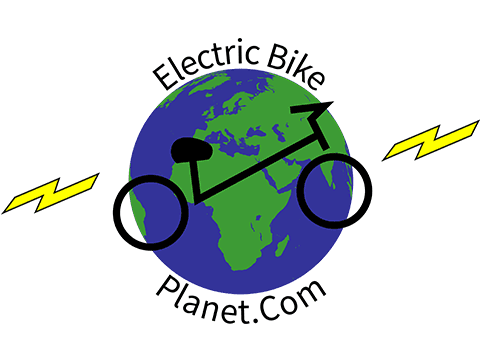
Captain Colyer is an expert in sustainable transportation with a Master’s degree in Environmental Engineering. With over 9 years of experience, he is dedicated to advancing eco-friendly commuting solutions. His work focuses on the latest advancements in electric bike technology and promoting sustainable living practices. At ElectricBikePlanet.com, Captain Colyer shares his in-depth knowledge and practical insights to help readers make informed decisions about electric bikes. Join them on their electric journey for the best e-bike advice and recommendations, and connect on Facebook, Pinterest, and Instagram.


